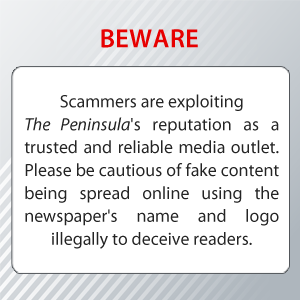
Doha, Qatar: As visitors step into the Qatar Foundation’s headquarters - 2015 building, the artwork made of porcelain artwork symbolises the connection between Chinese culture and the Arab world.
The artwork along the wall spells the Arabic word ‘Hash,’ meaning fragile in Arabic by using burnt gunpowder.
Fragile is an artwork by Cai Guo-Qiang, a Chinese-born New York-based renowned artist for his ‘explosion art,’ or gunpowder drawing.
Through art, Cai illuminates the relationship between China and the Arab and Islamic world that dates back to the ancient maritime Silk Road, using delicately sculpted tiles resembling the kind of porcelain manufactured near the artist’s hometown Quanzhou, a historical sea trading link to the Arab world.
Cai was commissioned by Mathaf: Arab Museum of Modern Art, based at QF’s Education City, to create his first solo exhibition in the Middle East in 2011: Saraab (meaning ‘mirage’), Mathaf’s first-ever show by a single artist. Fragile was part of this show.
“When I received the invitation to create in Doha, I faced the mysterious and miraculous culture of the Arab world. I decided to start from what I knew: the history of my hometown, Quanzhou,” Cai Guo-Qiang told The Peninsula in a sta tement.
“Historically, Muslims in Quanzhou were deeply engaged in society’s political, economic, and military sectors. Quanzhou and its daily life still retain hints of Islamic styling: the pointed arches, windows, roofs, and even the headscarf my grandma would often wrap around her head,” he said.
According to Cai, looking back at the history of human culture and continuing the stories of the past can spark an ‘inexplicable’ sense of excitement.
“My art is like a seed, sown in different cultures, growing, blossoming, and bearing fruit in different lands,” he says. “Art can transcend the ups and downs of politics and history, promoting dialogue between different people across cultures to better human society.”
He explains that Fragile’s name stems from the delicate relationship between gunpowder and ceramics and is a metaphor for the fragile relationships between people, cultures, and nations.
“Before this project, my artwork tended to be grander and stronger. Through this process, I learned that fragility is also important, and I incorporated the delicacy, restraint, elegance, and tenderness I discovered in Arabic culture.”
Incorporating Arabic letters into the art piece was a challenge for Cai, which was overcome with the help of a friend from Qatar. “They taught me how to write the Arabic word for ‘fragile,’” he says.
“I paid keen attention to the beautiful and delicate nature of this word, and practiced writing it repeatedly using Chinese ink calligraphy, and then experimented many times with gunpowder on ceramics.”
For his 2011 Saraab show in Qatar, Cai collaborated with 200 local volunteers, opening Fragile’s production process to the public. This made it an art installation and “a common memory in the local culture.”
“I remember that almost all the elementary school students from across the country stopped by at one point to see my creation process,” he said. “Sometimes, when they stopped by, I had not planned to light any fires, but not to disappoint them, I would explode a small work in front of them.”
Cai still feels that Arabic culture is a ‘fascinating mystery’ to him, one he can always return to and continue exploring.
“Although Qatar is one of the smallest countries in the Middle East, it boasts an unyielding courage and character,” he said. “I attended the opening ceremony of the 2006 Asian Games in Doha and witnessed Qatar’s ambitions, and I feel excited and proud watching Qatar’s influence growing among the world’s art and culture circles.”
“Qatar and Qatar Foundation are exploring ways to focus on Arabic culture while also gradually facing the multiculturalism the world has to offer. They are confident but with a sense of openness, as openness allows them to build towards an Arabic culture for the modern era confidently,” said Cai.





